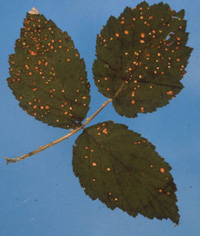Leaf spots occur most commonly on the lower portion of canes where conditions are favorable for disease development. Canes may also be infected – cane lesions are similar to those on leaves but more elongated in shape. Varieties differ in their susceptibility to leaf spot diseases. Eventually leaf spot infected leaves may turn yellow, brown, then drop off the plant.
The Raspberry Leaf Spot fungus (Sphaerulina rubi) causes typical frog-eye leaf spots with whitish centers and darker margins.


More Raspberry Leaf Spot information
Raspberry leaf spots are more circular in shape, larger, and occur later in the season than those of Anthracnose Leaf Spot.



